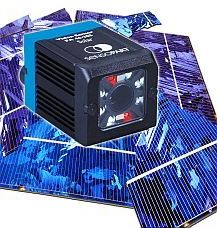Aug 27 2010
SensoPart Industries has added vision solar sensor FA 46 to its catalog of vision sensors. It is the only one of its kind in the market to measure each cell, thereby being able to detect even the minutest bevel irregularities or breaks, proving to be perfect for managing cell and wafer production.
It scrutinizes faults and breaks in crystalline solar cells, and is very economical and dependable. Due to its great accuracy levels, it links vision sensors which can compare contours, and image processing systems that are founded on PC technology.
 Vision solar sensor FA 46
Vision solar sensor FA 46
As silicon wafers are highly fragile, and can rupture very easily, it is imperative to identify bevel breaks well ahead of time i.e. when manufacturing process is done, to circumvent redundant costs, due to equipment breakdowns that may happen in the future. At present break controls are carried out by using image processing systems, that are PC based, which are not only very expensive to acquire but also equally expensive to install. Another disadvantage is that since these are simple vision sensors to compare contours, they fail to act at high levels of precision. This is where the FA 46 scores, as it is not only cost-effective, but also works to achieve precise measurements.
Whatever functions are necessary for a wafer and cell inspection, such as identification of wafer geometry, overcoming the defects that were identified, and modification of measurement, accuracy and processing speeds, have been configured formerly. Information about image processing is not needed for the configuration process. The consumer just has to feed in the pertinent inspection norms, such as acceptance of the size of wafers, amount and number of breaks in the wafer contours, and also its rotation and position, and then the operation is ready to begin.
The FA 46 identifies the varied cell forms, such as cells with or without bevel, poly crystalline, and mono crystalline cells eliminating the need to study the patterns or contours, as the sensor needs a reference contour only during the initial processes for an inspection of dimensional stability. The present day solar sensors execute only one contour comparison, whereas the FA 46 quantifies each solar cell or wafer singly without taking into account the rotation and achieves accuracy peaks. Every single image has to go through a directory correction before the study. The program has to be modified, so that it is capable of managing variables, when inspections of shining light and incidental light are carried out. To prevent wrong judgments, the contours of the solar cells could be faded out. This sensor has in addition an automatic position tracking system that permits the cell form to be identified separately, apart from its position in the handling system. The faded areas which are tracked on the basis of their position also go by the same policy.
The highest resolution for identifying bevel breaks is 2 x 2 pixels. Hence the FA 46 which assesses each individual cell recognizing even the tiniest bevel break could increase the precision levels, by studying the sub-pixels. It can locate the presence of acutely impaired cells and be further customized.
FA 46’s image processing unit consists of a camera within a compact sensor format, along with a proficient digital signal processor, LEDs with infrared or white or red light, input and output sockets and serial RS422 interface and Ethernet interface. The whole system, under operating conditions, is autarchic and does not need a PC, except for installing the sensor, with the help of SensoConfig, a configuration software. The software operates by using four steps namely job, location tracking, detectors and output, when the required function can be chosen and regulated. There is also an online help system and graded usage rights available to minimize errors.